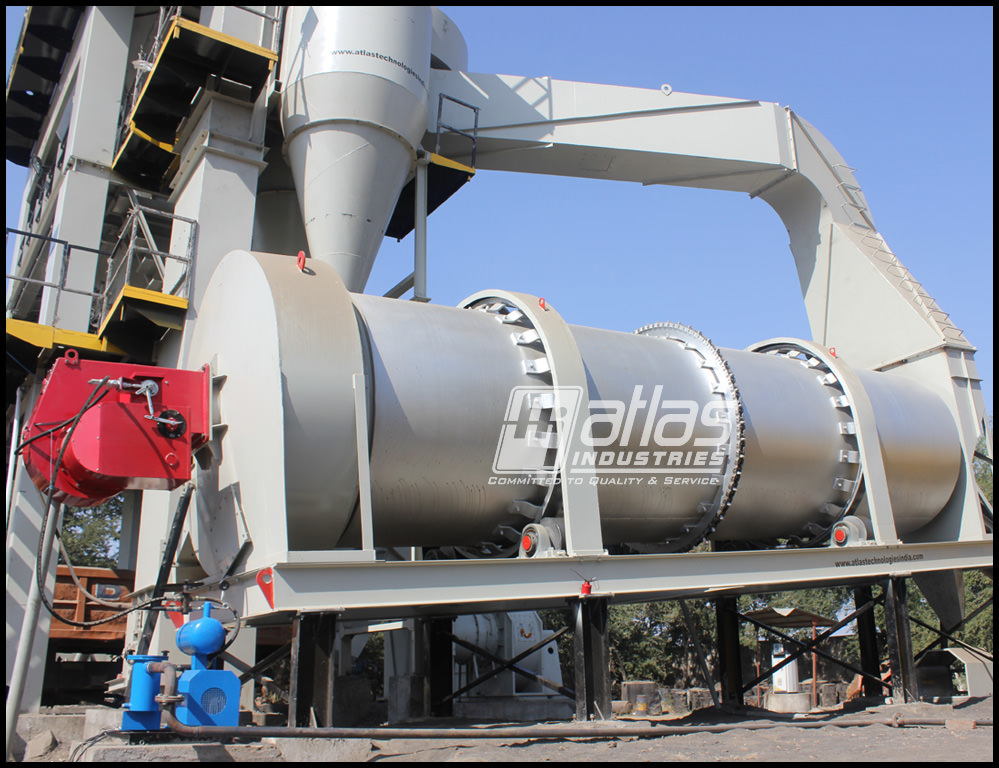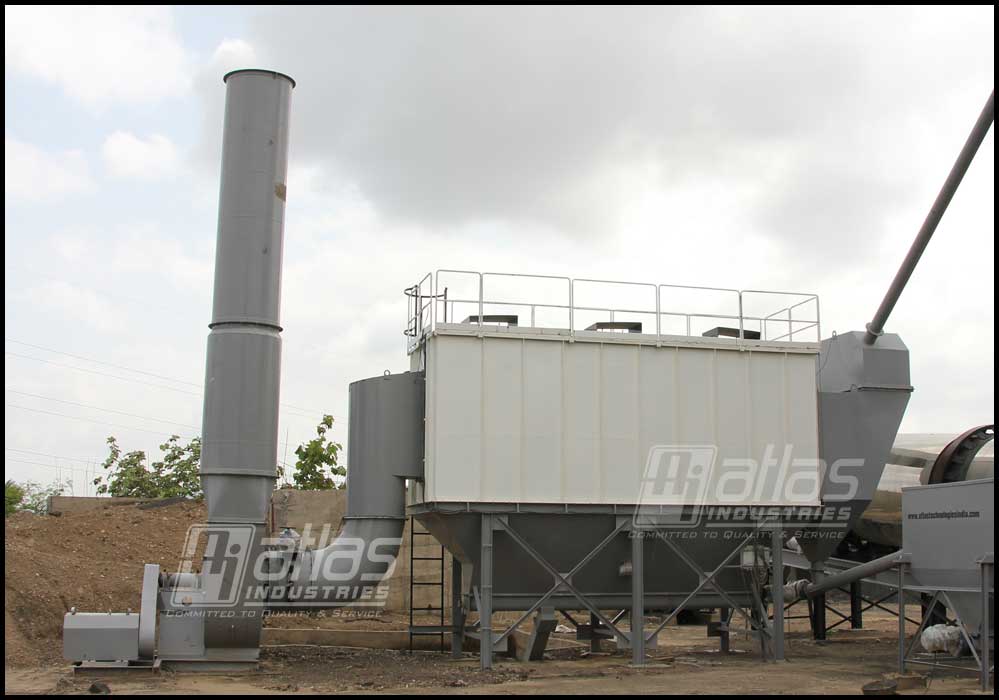The main components and operation of asphalt batch mix plant. It is to produce HMA known as Asphalt Batching Plant and hot mix plant. It blends together aggregates and bitumen to produce the hot mix paving material. The aggregates here can be a single sized material. It can be a combination of different grades / sizes of materials. Finer aggregates are also added along with mineral filler material. The binding material also known as asphalt cement can be cutback asphalt, synthetic binders or emulsion.
There are two major types of plants:
- Batch mix plants
- Continuous mix plant
The purpose served by both the plants is the same. The difference lies in the method by which they produce asphalt.

Asphalt Batch Mix Plant Operation:
The operation of asphalt batch mix plant starts from feeding the aggregates into the feeder bins. The operation ends when hot mix asphalt is discharged into the truck.
- The first step is to feed unheated-raw aggregates into different bins of the cold aggregate feeder. This feeding has to be as per their sizes. There are cold feeder gates on individual bins which will control the aggregates flow.
- The aggregates are then transferred to drying drum. A charging conveyor will transfer the aggregates to the drum.
- The drying drum comes fitted with a burner. Burner heats-dries the aggregates effectively.
- Most of the hot mix plants are equipped with a primary dust collector. It is for settling heavy dust particles.
- The primary dust collector works best with secondary dust collector. This secondary dust collector is a bag filter.
- Once the heating of aggregates is done in the drum, they are transferred to the tower unit. A bucket elevator is used to transfer the aggregates.
- On top of the tower unit we have the screening unit. It is multiple layered. As the hot aggregates pass through the screens they get treated to screening effect. They will get separated and stored into different bins based on their sizes.

- Separate hot bins are there. These help to separately store each type of aggregates.
- Aggregates are then weighed. After weighing these aggregates will be discharged in to the mixing unit. In the mixer, aggregates will be mixed with bitumen and filler material.
- Bitumen tanks heats and stores bitumen. It is equipped with a pumping station. Bitumen is pumped to the weighing hopper prior to discharge. This bucket weighs it before addition into the mixer. Filler material is added in a separate container and it is pumped to its weighing hopper. Only after weighing the filler material it is discharged into the mixing unit.
- After mixing for a fixed time, the hot mix asphalt is ready to discharge into waiting trucks. In some cases it is transferred to storage silos for storing the same temporarily.
- A control panel is for using/controlling the plant.
Asphalt Batch Mix Plant Process:
The process of asphalt batch mix plant is explained in details below. This equipment makes hot mix asphalt in batches. Each batch is of a specific proportion of each item that we need to mix.
Feeding cold aggregates:
This is the very first step. Different sized aggregates are fed into the different feeder bins. This helps in getting proper proportion of each size as per the need. Each bin will have individual gear and variable speed drive motor. It is possible to control the speed of each bin to get proper proportion of each item.

Aggregate heating by drying drum:
Drying drum is one of the important components of an asphalt plant. It is equipped with a burner unit on one side of the rotating drum. The drum is inclined and allows the material to flow freely from one end to the other. The aggregates are transferred to the drying drum after they pass through a primary screening unit. Once inside the dryer, the high temperature inside the dryer will help to get rid of the moisture content in the aggregates. Here the burner unit plays an important role. The lifting mechanism of the drying drum flights allows aggregates to heat up evenly.

Bucket elevator transferring the aggregates:
As soon as the aggregates leave the drying drum they enter the bucket elevator. Bucket elevator is a long and covered structure going up to the top of the tower unit. On top of the tower unit we have vibrating screen. The bucket elevator has many buckets that are attached to a chain. This elevator unit will transfer the heated aggregates to the top of tower unit and help them enter the top of the vibrating screen unit.

Hot Aggregates Screening:
On top of the tower unit we have the vibrating screen unit. This screening unit is multi layered and fully covered unit. Screens of different sizes are laid out in succession one below the other. As the aggregates fall on top of the first layer of the screen they will be treated to a vibrating effect. This vibrating effect will help the material to pass from one screen to the other. As they pass from one screen to the other the oversize material will be removed as they will not be able to pass through the top most screen.
Hot bins:
After the screening is over all the materials will be separated and stored in different compartments. These compartments are called as hot bins. They will store the aggregates and help in weighing the same before the aggregates are discharged into the mixing unit.
Bitumen and filler weighing mechanism:
Bitumen and mineral filler both are weighed before being discharged into the mixing unit. There is a circular and insulated bitumen weigh hopper which will store some quantity of bitumen. This hopper will weigh and discharge the required quantity of bitumen into the mixing unit. The filler hopper holds and also weighs filler material before discharging into the mixer.
Mixing unit:
Mixing unit receives aggregates from the weigh hoppers transferred from the hot bins. It also receives bitumen from the weigh hopper transferred from the bitumen tanks. Filler is also discharged from the filler weigh hopper. If there is addition of RAP it is weighed prior to discharging the same into the mixing unit. Mixing unit will mix all the contents thoroughly for a fixed time before discharging the contents into the truck or into storage silos. There are two horizontal shafts which have arms and tips fitted on them. These arms and tips will be rotating on the shaft for mixing of material inside the mixer. Mixers are jacketed so that contents inside stay hot.

Bitumen storage and transfer tanks:
Bitumen tanks act as storage point for bitumen used in the asphalt plant. Bitumen tanks are direct heating or indirect heating type. Direct heating type bitumen tanks will come with a burner fitted for heating of bitumen. The burner flame is led into a tube which will transfer the heat inside the tube for melting bitumen. Indirect heating system has coils running inside the bitumen tanks. These coils will continuously circulate hot oil inside the coils which in turn will heat the bitumen. Bitumen tank comes in different sizes as per the customers requirement.
Filler storage:
Mineral filler is an integrated component of asphalt batch mix plant. It will store filler material and then via a screw conveyor transfer the same to the filler weigh hopper. Size of the filler storage can vary as per the requirements of the customer.

Bag filter unit for pollution control:
Bag filter and pre separator are two important units for trapping harmful gases and dust particles. Pre separator will trap all the heavy dust. Bag filter is with number of bags close to each other in a closed chamber. As the gas sucked from the drying drum is made to pass through the bags they will be trapped. This action of the bag filters will help clean most of the pollutants and give out smoke with less pollution.
https://www.youtube.com/watch?v=n-UkeXy4qlY
Control panel:
Control panel is the controlling unit of the asphalt batch mix plant. The operator can control all the operations of the plant from the control panel. Control panel supplied by Atlas. It is a PLC type panel. It is highly advanced control unit with all important parameters laid out nicely. There is a touch screen HMI unit. It is easy to use and displays all important parameters in different screens nicely.
Asphalt Batching Plant Components:
The components of asphalt batching plant ensure that the plant works smoothly. It is necessary for all the parts to work in perfect synchronization. All the types of asphalt plants may have different components. But their purpose is to produce hot mix asphalt as per desired recipe.
Below are the components of asphalt plant
- Cold aggregate feed bins
- Primary vibrating screen
- Charging conveyor
- Drying drum with multi fuel burner
- Hot aggregate bucket elevator
- Pre-separator with bag filter
- Multi deck vibrating screens
- Hot bins
- Mixing unit
- Bitumen storage and transfer tanks
- Weighing hoppers for aggregate, bitumen and filler material
- Filler storage silo / hopper
- Control cabin and panel
- Asphalt storage silo
- Cold or warm RAP hoppers
Common operations of an asphalt mixing plant include heating of the aggregates and mixing them with bitumen and binder material. These process can be carried out in a simple way by a continuous plant or in a complex but more accurate way by a batching plant.
Asphalt batching plant is designed to produce hot mix asphalt in fixed batches. It weighs each component individually before adding them into the mixer to prepare a batch. The accuracy offered by an asphalt batching plant is more compared to a continuous plant.
The common types of asphalt mixers are continuous type and discontinuous (batch) type asphalt plants. Asphalt mixers are also available as stationary type as well as portable types.

